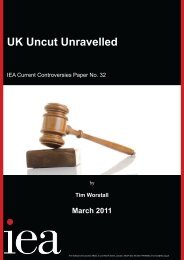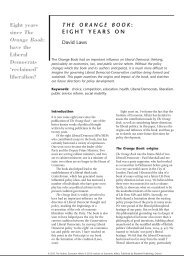THE MYTH OF SOCIAL COST.pdf - Institute of Economic Affairs
THE MYTH OF SOCIAL COST.pdf - Institute of Economic Affairs
THE MYTH OF SOCIAL COST.pdf - Institute of Economic Affairs
Create successful ePaper yourself
Turn your PDF publications into a flip-book with our unique Google optimized e-Paper software.
S. N. S. CHEUNG<br />
A more general statement can now be made regarding the<br />
constraints under which the traditional measure <strong>of</strong> economic<br />
efficiency will be attained. First, assignment <strong>of</strong> exclusive rights<br />
to either A or B is essential, and either case will yield similar<br />
results. (The alternative assignments <strong>of</strong> rights, involving alternative<br />
liability rules and different distributions <strong>of</strong> wealth,<br />
could lead to different patterns <strong>of</strong> resource use due to the<br />
distribution effects, but this would not affect efficiency.) A<br />
second constraint is that all costs associated with making<br />
transactions are zero. These two propositions summarise what<br />
has been called the Coase theorem.<br />
COMPLICATIONS<br />
[This section can be skipped by non-economists—ED.]<br />
Complication 1: Uncertain transaction costs<br />
This illustration gives rise to several important complications which<br />
should be examined, to clarify our understanding <strong>of</strong> social cost and<br />
to facilitate subsequent discussion <strong>of</strong> the appropriate specification<br />
<strong>of</strong> constraints. To demonstrate the first complication, return to the<br />
situation where Neighbour B has the right to exclude damage by<br />
Factory Owner A. We have discovered that the total gain <strong>of</strong><br />
increasing input from o to 4 units is £24 (Column 16), but how is<br />
this gain to be divided between A and B? No matter how it is<br />
apportioned, assuming transaction costs to be zero, 4 units <strong>of</strong> input<br />
will be employed. But this result merely follows tautologically from<br />
the postulate <strong>of</strong> constrained maximisation. How can there be any<br />
other outcome if all parties are able to maximise by contracting<br />
without cost to them? The question <strong>of</strong> division <strong>of</strong> the gain must<br />
first be solved. Either party may capture the entire amount; but no<br />
criterion or mechanism is specified through which a division may<br />
be determined, and without an answer to this question we cannot<br />
predict the behaviour <strong>of</strong> the individual parties.<br />
Bilateral monopoly<br />
The problem here is identical to that <strong>of</strong> a monopolist (single seller)<br />
dealing with a monopsonist (single buyer): the solution has long<br />
been regarded as indeterminate. <strong>Economic</strong> theory fails to yield any<br />
definitive implications because the constraints are inadequately<br />
specified. In such a bilateral monopoly, the transaction costs are<br />
significant because <strong>of</strong> a lack <strong>of</strong> competitive forces to reduce them.<br />
To assume away such costs, therefore, is to commit the same<br />
[46]












